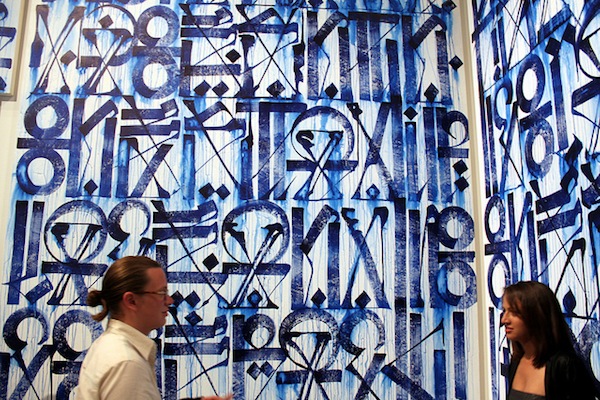
Last week, The Los Angeles Museum of Contemporary Art opened an exhibit of street art and graffiti that promised to go down in history, Art in the Streets. It’s a massive exhibit of over 100 street artists and graffiti writers. I visited AITS three times, and still wasn’t satisfied that I’d appreciated the show fully. I think MOCA has delivered something special, but maybe did not quite fulfill that original promise.
I want to spend a good amount of time addressing criticisms of AITS, because that should not be ignored, even if they are far outweighed by the good of the show.
This isn’t the show that I would have put on. This isn’t the show you would have put on. AITS is the show that only Jeffrey Deitch, Roger Gastman and Aaron Rose would have put on. Artists that I would have included without a moment’s hesitation (Judith Supine, Faile, Brad Downey, Jenny Holzer…) were oddly absent, and some artists in the show were out of place or allotted too much space (Geoff McFetridge, Terry Richardson, Mr. Cartoon…). For a show attempting to paint the picture of a history, the historical timeline was given a strange second billing to a hodgepodge of individual artist installations.
The selection process for a lot of the show seems like it was a political battle rather than an ideal model of art curating. When the curators’ names were announced, a good chunk of the show’s line up could already be predicted based on their personal relationships. Luckily, the curators are connected to many of the same people that anyone would have put in a similar show to AITS. What would this sort of show be without a contribution from some Beautiful Losers and artists who had shown at Deitch Projects? The unfortunate thing is that there definitely could have been less of a focus on those well-connected artists, and the many talented artists who aren’t connected to the curators probably had a harder time getting invited to be part of the show (or weren’t invited at all).
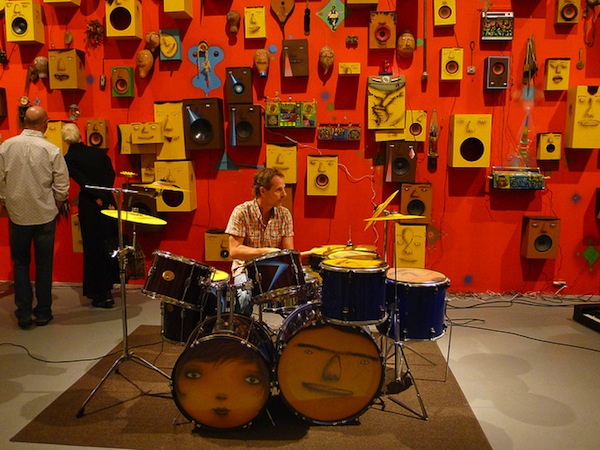
Briefly, it’s worth mentioning the lack of strong political artwork in the show. Any political statements made were “safe” ones, and the most controversial (Blu’s message of “war sucks and people make money off of it”) was removed. But just as all illegal street art and graffiti is inherently political, putting work by street artists and graffiti writers in a museum is a political act, even if the content of the work is not explicitly political.
The outdoor murals and the way MOCA has generally dealt with truly accepting the “street” side of street art and graffiti has also been a bit of a mess, but I think that would be true of almost any institution of MOCA’s size. The buffing of Blu’s mural and then the buffing of Katsu’s tag both tainted AITS, regardless of MOCA’s right to do what they want their walls, and the murals that replaced those two are not fantastic (although Push and Futura’s contributions to Lee’s mural work pretty well). And just this past week, Deitch’s inability to publicly defend and embrace illegal street art being committed near the museum has been laughable and depressing. Critics of the show are right to point out the hypocrisy of his position on the legitimacy of street art being produced today versus that of a few years ago. But just like it is the critics’ job to point out that hypocrisy, it is Deitch’s job to say politically wise things to reporters. Simply put, MOCA haven’t been very ballsy when it comes to the “in the streets” part of “Art in the Streets.” This minor fail is maybe what best points out what AITS is and what it isn’t.
In essence, the show has the wrong name. It is not “art in the streets.” It is “documentation of art in the streets or art by artists who began their careers by making art in the street but probably don’t do that too much now, or maybe they do but this is a different side of their artwork.” Yes, a lot of these artists still get up outdoors, but, for many but not all of the AITS artists, it’s a different sort of thing these days: OBEY posters are advertising, Banksy stencils are tourist attractions that last a few days before ending up on eBay and Steve Powers paints amazing murals for an organization founded with the expressed purpose of covering graffiti like his. I’m not saying that artists can’t or shouldn’t evolve, but many of the street artists and graffiti writers that AITS focuses on make “museum friendly” art. And that’s great for them. But AITS is not a show of art in the streets but art by artists who have, as I’ve heard a few people put it, “graduated” from the streets, even if they still get up a bit. As Unurth points out, there is a general lack of names from the last 10 years. So let’s reframe this for what the show is, and look at it that way. Putting aside the politics and minor flaws that only a street art or graffiti fanatic will pay much attention to, AITS is a huge hit.
AITS has two main components: it has a brief history of street art and graffiti, and it has mini-shows of fine art from some of the most acclaimed street artists, street culture documenters and graffiti writers over the last few decades.
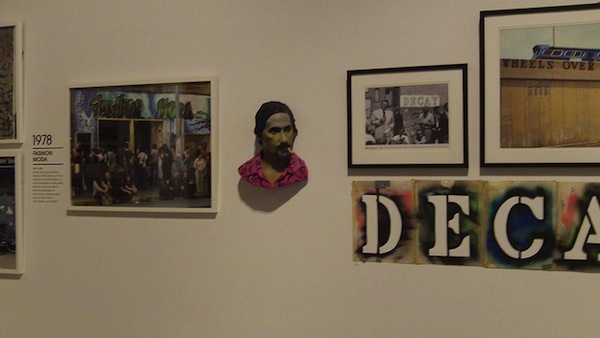
The timeline is the most “museum-y” part of the show, and it should provide newcomers a history of what graffiti, street culture and street art are about, as well as give long-time fans some new insights. While visitors should also take a trip to see the show currently on at Subliminal Projects to get a better idea about 1980’s street art in NYC, the timeline definitely does its job as a brief overview of the history informing the rest of AITS.
Most of the highlights of the show can be found in the installations.
Three of the best installations make a point of acknowledging that their work is in a museum, even though AITS is meant to be about illegal outdoor art. I’ve said it before and I’ll say it again: Street art and graffiti is about good placement and understanding context. Neckface, Os Gêmeos and the trio of Barry McGee, Todd James and Steve Powers all understand this very well, and it came across in their installations.
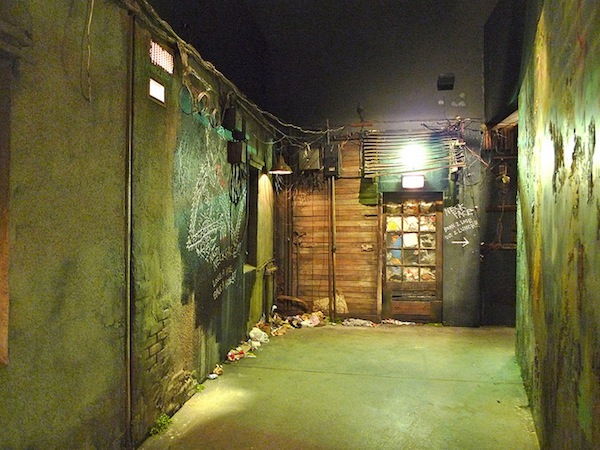
Neckface’s section was billed as one of his “haunted house” installations, but ended up being a recreation of a dark inner-city alleyway (complete with a drunk, drugged up or just plain crazy homeless man) with some Neckface tags on the walls. Of course, suits and bloggers like me were lined up to check it out, but few of us would be smiling so much if we actually found ourselves alone in that sort of an alleyway at 3 in the morning. That’s the street, the thing MOCA is supposed to be celebrating. It is like a voyeuristic natural history exhibit for historically middle and upper class museum visitors, pointing out the impossibility and absurdity of bringing the streets indoors in the fashion that the title of the show suggests.
Os Gêmeos reinstalled a show that they had last year at a museum in Portugal. It was definitely a highlight of the show, with a little bit of everything from the twins. Hidden in a bit in their cluster of work was one piece of wood where it was written: “This is not graff the graffiti is outside!!” Simple. That installation is their fine art and it is awe inspiring and thought provoking and should be seen. The graffiti is outside. And so is the street art.
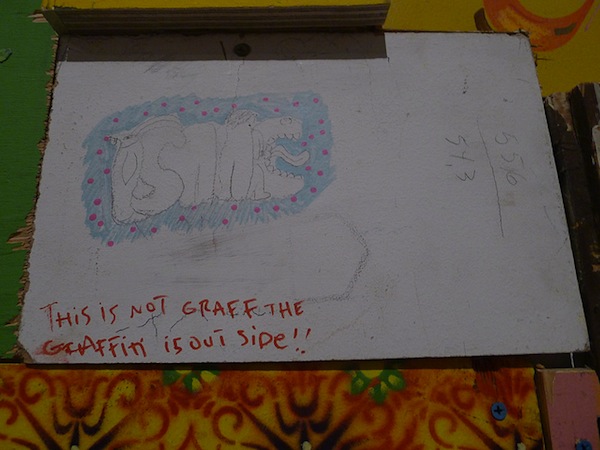

And then there is Street. Barry McGee aka Twist, Steve Powers aka ESPO and Todd James aka Reas reunited to make a new version of their historic Street Market installation, versions of which had previously been put on at Deitch Projects and the Venice Biennale. First of all, this might be the best installation in the show. Particularly when the area isn’t too crowded with other museum-goers, it’s like being transported into another, more Technicolor and mad, world. It’s a graffiti writer’s urban dreamworld where taggers can hide invisible bushes and bodegas sell cans of street cred. The space is an art-crowd friendly dreamworld of a street, where Style Wars isn’t a documentary but a musical without any real-world consequences. Again though, the installation touches on the impossibility of bringing a true street inside, going for the asurd illusion instead. Street is what would happen if graffiti writers could have a ride at Disneyland, and I mean that in the best way, but it’s still a ride at Disneyland rather than an actual street and the artists know it.
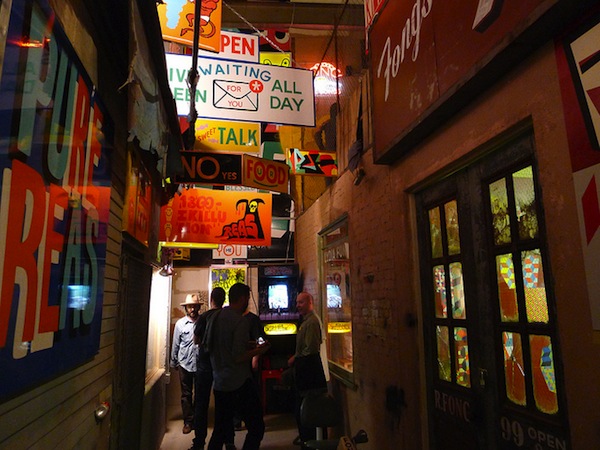
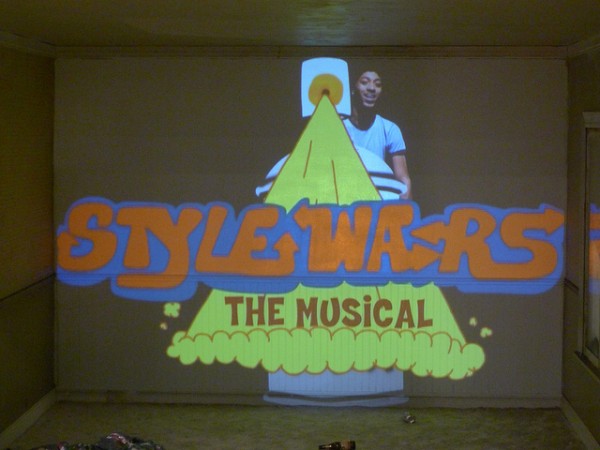
The show is just too massive to write about everything. This review is already far too long. Sections by Margaret Kilgallen, Roa (who again, understands that he is in a museum), Invader (who plays with the fact that he is in a museum), Shepard Fairey, Banksy, The Fun Gallery, Rammellzee, Retna, Chaz Bojorquez, Swoon, Kaws, Ed Templeton and many others add together to be the most substantial gathering of art by this group of artists that has ever been assembled. I rediscovered artists I’d overlooked, found new favorites and enjoyed revisiting the work of my old favorites. The show is so massive that a pessimist will undoubtedly find something that they do not like and many visitors will be overwhelmed, but it would be difficult to go through the entire show and not find a few gems, no matter your taste in art.

For a moment, forget about the BS and the politics and the buffing and Deitch-hating and Alleged Gallery controversies from a decade ago and the lack of this person and that person and why this person got an installation and that person painted a mural and blah freaking blah. Outside of our art-world BS political pissing contest context where AITS can and will be criticized on many levels, people are going to visit AITS and they’re going to see some amazing art by artists who were and are pillars of street art and graffiti history. I expect that the vast majority of visitors will like what they see and they will learn something. And that’s important. This is street art. It’s supposed to be for “the people,” and “the people” will still enjoy this show even if my or your 4th favorite artist was snubbed or whatever other minor flaw you can find. And if you go and visit the show and you can put aside your minor internal art world squabbles for a couple of hours, AITS should be a magical experience for you, just as it was for me. I highly recommend setting aside a day to visit AITS.
Photos by Lord Jim, Gelatobaby, LindsayT and RJ Rushmore

